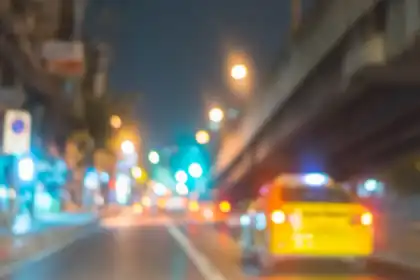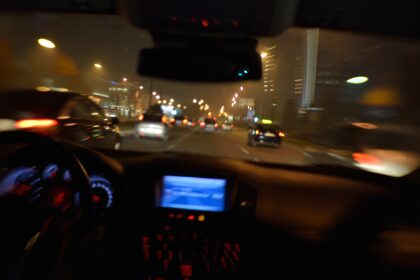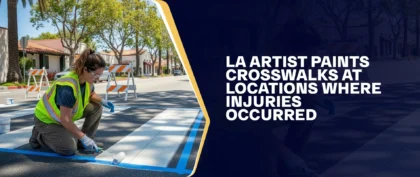Table of Contents
Nighttime driving presents unique challenges that many drivers often underestimate. While the roads may seem quieter and less congested after dark, the risks associated with driving at night are significantly higher than during the day. According to statistics, more than half of all fatal traffic accidents occur at night, even though only a small percentage of driving happens from sunset to sunrise.
Driving at night is riskier than driving during the day. It’s harder to see obstacles, pedestrians, and other vehicles. Plus, there’s a higher chance of encountering impaired drivers since evening hours see more alcohol consumption. Also, our body’s natural clock tells us to rest at night, leading to more sleepy and tired drivers on the road.
Understanding these challenges is essential for every motorist to promote safety at night. They must be more cautious, adjust their driving habits, and take proactive steps to minimize risks.
Common Challenges During Nighttime Driving
According to MoneyGeek, only 9% of driving occurs between sunset and sunrise. However, 49% of accidents that result in death occur during this period. Nighttime driving brings its own set of challenges. The risks are still high even with advanced safety features in modern cars. Seeing obstacles, pedestrians, and other vehicles in the dark is harder.
Newer cars in the U.S. have brighter headlights, which can cause issues like glare and afterimages for other drivers. Some vehicles use LED and laser lights, creating blinding flashes that make nighttime driving more dangerous.
Here’s a deeper look into the everyday challenges drivers face after dark:
Reduced Visibility While Driving At Night
One of the most significant challenges of nighttime driving is reduced visibility. As darkness falls, drivers’ ability to see the road, obstructions, and other vehicles becomes severely limited, making reacting to sudden changes or hazards more difficult.
Even with modern headlights, driving at night presents a greater risk than daytime driving because there is less ambient light to help drivers navigate. This condition is especially problematic on poorly lit roads, where streetlights may be sparse or nonexistent, making identifying hazards like pedestrians, animals, or dangerous road conditions harder.
A vehicle’s low-beam headlights typically light up about 160 to 200 feet of the road ahead. When you’re driving fast, this isn’t much help. Spotting obstacles or reacting quickly to other drivers’ unexpected moves is tough. Plus, navigating curves or intersections at night can be tricky since it’s harder to judge distance and speed. This can lead to dangerous miscalculations and increase the risk of accidents.
According to the American Academy of Ophthalmology, color vision is poor in low light, and night vision is predominantly black and white. This shift in vision can make it harder for drivers to see objects or hazards similar in color to the surroundings, such as dark-colored pedestrians or animals. The lack of contrast between these objects and the background makes visibility even more challenging.
Impaired Night Vision
Night vision is the ability to see clearly in low light, but this ability diminishes significantly after dark. According to a study by the University of Michigan Transportation Research Institute, fatal pedestrian accidents occur 22% more often on nights with a new moon, where the moon is practically invisible, than on full moon nights. This data highlights how even minor variations in natural light can substantially impact safety.
Dr. Sumitra Khandelwal, a professor of ophthalmology at Baylor College of Medicine in Houston, explains that pupils become enlarged at night, causing nearsightedness. This dilation increases sensitivity to light, resulting in more glare and halos around headlights or streetlights. It can also reduce the effectiveness of prescription glasses and contact lenses.
Another challenge of nighttime driving is being less aware of your surroundings. This state is mainly due to reduced peripheral vision in low light, making it harder to see things beside the road. The darkness limits what you can see, increasing the difficulty of spotting potential dangers on the sides of your vehicle.
Age-Related Vision Degradation
As people age, their ability to see at night naturally decreases, significantly impacting driving ability. For example, a 50-year-old may need twice as much light to see clearly as a 30-year-old. The American Optometric Association notes that drivers aged 60 and older may face even more significant challenges when driving at night. Several age-related eye conditions can impair night vision, making it harder for older drivers to navigate safely in low-light conditions. These conditions, as outlined by the association, include:
- Age-related macular degeneration
- Diabetic retinopathy
- Glaucoma
- Cataracts
- Retinal detachment
- Dry eyes
John Bullough, the Light and Health Research Center Director of Mount Sinai Hospital’s Icahn School of Medicine, says human pupils, which control how much light enters our eyeballs, also become smaller as we age. Older people’s eyes take in less light despite the same light level.
Bullough noted that over half of individuals will develop cataracts by age 80. He asserts that cataracts will develop in everyone who lives long enough, regardless of how healthy their eyes are.
With age, most people also lose sensitivity to contrast changes, making it more difficult to recognize things like traffic signs, other vehicles, or pedestrians. This condition is a common reason for elderly driving accidents.
The Moth Effect
The Moth Effect highlights a real but under-recognized danger of nighttime driving. The “moth effect” is a theory suggesting that nighttime drivers subconsciously gravitate toward lights, much like moths to a flame.
Despite being a plausible theory, limited scientific evidence supports the Moth Effect. Accident reports never explicitly cite it, making it hard to measure. However, experiments have attempted to study this behavior.
A study by Virginia Tech involved fatigued drivers in simulated conditions. Out of 21 participants, only one showed behavior consistent with the Moth Effect: veering toward a lead vehicle with flashing hazard lights after nearly an hour of monotonous driving. Factors like close following distance, driver fatigue, and the absence of eye-tracking devices contributed to this behavior. While this supports the theory, it also suggests the effect might not be widespread.
This involuntary fixation on bright lights, such as hazard lights on a parked car or oncoming headlights, can cause drivers to unintentionally steer toward the light source. Drivers navigating poorly lit roads can easily get disoriented. Furthermore, focusing on a single light source limits drivers’ awareness, reducing their ability to detect pedestrians, other vehicles, or road hazards in time.
To avoid the Moth Effect, drivers should focus on the road ahead and use their peripheral vision to monitor lights. Maintaining a safe following distance and avoiding direct eye contact with oncoming headlights can also help. Staying well-rested and taking regular breaks during long drives can reduce fatigue, further mitigating the risk of the Moth Effect.
Highway Hypnosis
Unlike obvious distractions like texting or eating, highway hypnosis creeps in unnoticed. Drivers can lose awareness while controlling the vehicle, which can be fatal if sudden obstacles or traffic changes occur.
Road hypnosis is more dangerous at night due to a mix of environmental factors and the body’s natural tendencies. Driving in the dark already poses risks due to reduced visibility. Fewer visual cues and sleepiness after dark create the perfect conditions for mental disengagement while driving.
Long, empty roads and familiar routes worsen the problem, lulling drivers into overconfidence and mental autopilot. This state makes it easy to miss critical hazards, like sharp turns, pedestrians, or stopped vehicles. They can go undetected until it’s too late. Even a slight delay in reaction can turn deadly.
Glare From Headlights
Driving at night can be challenging for everyone, regardless of their vision. One of the most common and dangerous problems for drivers is glare from headlights. Vehicles with high-intensity headlights can temporarily blind oncoming drivers, making it difficult for them to see the road.
Here are some of the things that could happen when drivers come across bright headlights:
- Momentary Vision Impairment — The intense light can temporarily impair vision, causing drivers to swerve or even hit the curb. It will also make it harder to spot pedestrians, other vehicles, or road hazards. For some drivers, it may take several seconds to recover from the glare, which increases the risk of car accidents due to impaired vision.
- Loss of Focus — To avoid the blinding light, drivers may unintentionally divert their attention from the road. This distraction can lead to them overlooking important road signs, failing to notice other vehicles, or being unable to react to sudden changes in traffic. The longer drivers take to recover from the glare, the more their concentration is compromised, which further increases the likelihood of a traffic accident.
Another issue to think about is the height of headlights in different cars. Drivers of sedans might struggle with the bright lights from SUVs since those lights are positioned higher.
Many Automotive Headlights In Use On The Road Today Are Inadequate
As advanced as the United States may be, it lags far behind in road and vehicle safety standards, according to Greg Brannon, Director of Vehicle Engineering and Industry Relations at the AAA Foundation for Traffic Safety.
In 2022, the National Highway Traffic Safety Administration (NHTSA) released U.S. auto safety rules allowing Adaptive Driving Beam (ADB) headlights. The rule amended the Federal Motor Vehicle Safety Standard No. 108, “Lamps, reflective devices, and associated equipment.”
However, automakers and safety advocates said these new regulations make it challenging to incorporate the features. NHTSA regulations require ADBs to respond exceptionally quickly to another vehicle after they are detected, much faster than other standards in other countries. Unfortunately, the availability of these advanced headlights in the United States will likely be years away.
Here are some of the benefits of ADB headlights:
- Selective Dimming — Adjusts the driver’s view while keeping oncoming drivers from being blinded. In the U.S., headlights automatically switch between high and low beams for better night visibility. ADBs improve this by constantly adjusting the light to reduce glare, shining more on empty areas of the road and less on those with cars.
- Safer Roads for Pedestrians and Cyclists — With adaptive lighting capabilities, pedestrians and other road users are much easier to see. The lack of glare also reduces road incidents such as pedestrian accidents and bicycle collisions since drivers can react more quickly.
- Advantage in Certain Weather Conditions — Smart headlamps are helpful in foggy conditions since they illuminate the road well in front and on the sides. This feature can prevent blinding reflections from causing danger to drivers.
Some luxury cars in the U.S. already come with headlights that can adapt to different driving conditions. However, the necessary software for these adaptive features is not yet available. Automakers are also having difficulty meeting the new ADB standards.
The Impact Of Fatigue And Drowsiness On Nighttime Driving
Fatigue and drowsiness make driving tricky at night. When we’re sleepy, our ability to make good decisions and react quickly is impaired, similar to driving under the influence of alcohol. This drowsy state poses risks to the driver and everyone on the road, increasing the chances of accidents and injuries.
Here are some similarities between drunk driving and drowsy/fatigued driving, according to the National Safety Council:
- Losing two hours of sleep is as dangerous as drinking three bottles of beer. Exhausted drivers are three times more likely to be involved in a motor vehicle accident.
- Research shows that being awake for 17-19 hours produces driving performance equivalent to having a blood alcohol concentration of 0.05%, and being awake for 24 hours is similar to having a BAC of 0.10%.
Risks Of Microsleep And Highway Hypnosis
Fatigue symptoms can go unnoticed by drivers, so they might not realize they’re tired. When tired, they may experience short naps (microsleep) or a trance-like state (highway hypnosis). According to the National Sleep Foundation, microsleep is when you fall asleep for several seconds without even realizing it.
Highway hypnosis is a condition where a driver feels like they’re in a trance while driving. They can lose track of time, not notice how fast they’re going, or forget what they’ve passed on the road.
Both conditions pose risks, as they involve losing attention while behind the wheel. Distracted driving, even for a few seconds, is dangerous. Microsleep episodes usually last four to five seconds, which is enough time for a vehicle to travel the distance of a football field at highway speed.
Dangers Of Drowsy And Fatigued Driving At Night
Sleepy or tired drivers cause many accidents. Determining whether a motorist was exhausted during the collision can be difficult, so getting an annual estimate of drowsy-driving incidents can be challenging.
Data On Drowsy Driving
Drowsy driving is more common than you think, and it often causes accidents, as demonstrated in the following numbers:
- According to NHTSA data, drowsy-driving crashes led to 693 fatalities in 2022.
- A study by the AAA Foundation for Traffic Safety found that drowsy driving is a factor in around 8.8%–9.5% of all crashes.
- Traffic safety research indicates that drowsy driving contributes to a significant number of crashes annually, many resulting in serious injuries and fatalities.
Contributing Factors To Fatigue And Drowsiness
Several factors can contribute to fatigue and sleepiness. These can be external factors or certain medical conditions. Here are some of them:
- Long commutes
- Longer work hours
- Lack of quality sleep
- Sleep deprivation
- Circadian rhythm disorders
- Sleep apnea
- Certain medications
Many types of medications could cause drowsiness, such as antidepressants, antihistamines, high blood pressure pills, painkillers, and more.
Drivers need to be aware of the signs of fatigue and drowsiness. Being proactive about sleep management and rest schedules can help. Similarly, drivers who have specific medical issues should be able to assess their physical condition before operating a vehicle.
Road Hazards At Night
Road hazards are common. However, they are more dangerous at night when some drivers hardly notice them. Here are some common road hazards at night:
- Wildlife — Nocturnal animals are often involved in these accidents because they are more active at night. However, deer are also often involved in road collisions. According to a 2022 study in the journal Current Biology, there are approximately 2.1 million deer-vehicle collisions annually, accounting for an estimated 59,000 human injuries and 440 fatalities each year. Generally, deer are on the move between late October and early December. They prefer to move early in the mornings and early evenings.
- Construction Work — Highway construction is usually done at night to avoid daily traffic. While most construction projects are marked and barricaded, you may still encounter roadwork or construction sites without these safety precautions.
- Unseen Road Obstacles — The dark makes it harder to notice potholes, trash, and even roadkill. These dangerous road conditions and clutter can lead to accidents, from minor fender-benders to serious collisions.
Slow down or stop to avoid hitting wildlife or other obstacles. Swerving may only lead to a crash with oncoming traffic. Staying attentive while driving allows you to react appropriately and safely to such situations.
Drunk Driving Is Common At Night
Drunk drivers pose one of the most significant risks to driving. No matter how careful you are when driving, you can still get into a DUI accident if you encounter a drunk driver.
It is more common for drunk drivers to be on the road at night. Although alcohol consumption is acceptable when there are gatherings or meetings, nothing good comes out of it when done excessively.
There is a higher rate of drunk driving in the evening, especially between 6 p.m. and 2:59 a.m. Drunk drivers cause approximately one-third of all traffic fatalities. The NHTSA reported that in 2022:
- Between 9 p.m. and 11:59 p.m. (45% of the total number of reported crashes during this time)
- 2,645 accidents that occurred between midnight and 2:59 p.m. (55% of the total number of reported crashes during this time)
- 2, 312 accidents that occurred between 6 p.m. and 8:59 p.m. (34% of the total number of reported crashes during this time)
All the figures above are related to alcohol-impaired driving involving both single- and multiple-vehicle crashes. The agency assumes that alcohol is involved when alcohol tests are unknown. They also consider a situation an alcohol-impaired driving incident when at least one driver involved has a blood alcohol content of .08% or higher.
If you were injured because of a drunk driver, consider consulting a personal injury lawyer who handles similar cases to understand your rights and potential legal options.
How Dangerous Is Nighttime Driving?
Several factors affect driving at night. Besides limited visibility, road hazards and bright headlights can still affect some drivers. In addition, you should consider the drivers who are tired, drunk, or suffering from medical conditions.
With these risks, drivers are more likely to get into an accident at night and need extra caution to avoid these incidents.
Nighttime Driving Statistics And Facts
Numerous studies and statistics have established that driving at night poses a serious risk to road safety. In 2022, according to the Insurance Institute for Highway Safety (IIHS), there were 14,007 deaths in motor vehicle accidents at night. This figure represents the total number of accidents between 6 p.m. and 9 p.m. and 9 p.m. and midnight. Several factors are causing this, including poorer vision, fatigue, and intoxication.
Apart from reckless behavior and road hazards, another angle we could look at is the risk of accidents involving teen drivers. Studies show teens and young adults are more likely to be involved in fatal crashes.
A recent report from the Insurance Institute for Highway Safety explains the potential risks among teen drivers and the dangers of night driving. According to the report, there are three times as many fatal crashes at night among teens (ages 16-19) as among adults (ages 30-59) in the U.S. Inexperience, reckless driving, and driving at night are likely contributing factors.
Addressing these issues through driver education, graduated licensing programs, and targeted safety campaigns can reduce the number of nighttime driving-related accidents and fatalities.
Legal Requirements And Regulations For Nighttime Driving
In addition to safety and practical considerations, drivers must be aware of and comply with legal requirements and regulations for nighttime driving. These rules establish consistent standards and help protect the safety of all road users during night hours.
- Properly Functioning Lights — Federal regulations require that all vehicles have properly functioning headlights that meet safety standards for brightness and visibility. In most jurisdictions, vehicles must have visible front and rear lights.
- Limits on Using High-Beam Headlights — Some states require drivers to lower their high beams when driving in places with plenty of street lights or when approaching or following other vehicles. Failure to comply may lead to citations and possible blame in a collision.
Tips For Safe Nighttime Driving
Drivers should practice precautions while driving. Given the challenges and risks during night driving, drivers must be extra cautious.
Though driving less at night is advisable, this is not an option for some people. Some work night shifts and may need to travel at night. Taking the appropriate safety measures makes night driving a lot safer. Here are some tips:
Practice Defensive Driving
Defensive driving involves using careful and deliberate techniques to lower driving risks. Drivers should be alert and help protect the safety of others on the road, including other drivers and pedestrians. Here are some of the best practices for defensive driving:
- Slow Down — You have more time to respond to risks when you drive slower. You can also prevent intersection accidents if you’re approaching it at a slower speed.
- Maintaining a Safe Following Distance — When you leave adequate space between your car and the one in front, you can react and brake more quickly. Larger vehicles, such as trucks, also have different stopping distances than smaller vehicles, like sedans or motorcycles. To avoid truck accidents, truck drivers must also consider their stopping distance.
- Don’t Overuse Your High Beams — High beams help you see farther, but should be used only when needed. They can blind drivers coming toward you. Don’t use high beams when turning, facing oncoming traffic, going uphill, or in bad weather.
Keep Your Eyes Alert
Be aware of pedestrians and wildlife by regularly checking your surroundings, especially in narrow or dimly lit areas. Also, watch out for other drivers. Look for signs of impairment such as inconsistent speed, weaving, or driving without headlights. If you suspect someone is impaired, keep a safe distance and move out of their way if possible.
Make Sure Your Car Is In Good Condition
Check your brake lights, taillights, turn signals, and headlights before driving at night. Over time, headlight lenses can become cloudy and discolored, reducing their effectiveness. Regular cleaning and repair of headlight lenses can enhance nighttime visibility. Proper alignment and aiming of headlights will also maximize coverage and minimize the impact of glare on other drivers.
Clean your windshields so you can see easily and other road users can readily see you. According to the NHTSA, dirty or damaged windshields can scatter light and potentially increase the effects of glare.
Additionally, check that your tires are inflated according to the manufacturer’s specified levels and have adequate tread to help avoid tire blowouts or other tire-related incidents. Even though your tires are relatively new, issues could lead to defective tire injuries.
Make Sure You Are Fit To Drive
You should have your eyes checked. Some people become more sensitive to glare as they age, and some may also experience blurry vision due to astigmatism. Consider wearing special nighttime driving glasses to prevent blurry vision and light glare.
You should only drive if you are well-rested. If you feel tired, take a break, stretch your legs, and grab a meal at a rest area or gas station. If you believe you are not fit to drive because of fatigue, intoxication, or any other reason, choose not to drive.
The Role Of Technology In Enhancing Nighttime Visibility
Headlights are the primary source of road lighting to increase visibility while driving at night. Traditional halogen headlights have limited brightness and beam patterns, but newer technologies like LED and HID provide better illumination and energy efficiency.
Advancements such as night vision systems enhance visibility by detecting objects’ heat signatures and displaying them on a screen. While Adaptive Driving Beam (ADB) lights are not yet standard, many safe-driving technologies are available in certain vehicles.
When choosing these features, consider your driving habits, locations, and any medical conditions you may have.
Frequently Asked Questions
What Is The First Thing You Do When Driving At Night?
Remember to use your headlights. Generally, you must turn on your headlights 30 minutes after nightfall and until 30 minutes before sunrise. Driving at night with your headlights on is essential for the safety of other drivers, pedestrians, and yourself. You may have a more challenging time spotting other cars in the dark. Having both your headlights and taillights on at the same time reduces the chance of a rear-end collision.
Is It Normal To Struggle With Driving At Night?
Everyone sees better during the day than at night. Even with perfect vision, you may still find driving hard at night. However, some people may find nighttime driving particularly challenging due to certain medical conditions.
- Night Blindness or Nyctalopia — If you often bump into things in the dark or struggle to drive at night, you might have night blindness. This condition doesn’t mean you cannot see in the dark, but it can make it hard to see clearly in low light. Night blindness can limit your ability to drive safely and put you and others at risk.
- Astigmatism — Driving at night can be particularly challenging for individuals with astigmatism, a condition caused by an irregular eye curvature. This irregular shape distorts light as it enters the eye, making it harder to see clearly at night. This causes blurry vision, glare, and halos around lights.
- Night Myopia — With night myopia, pupils dilate (or widen) more at night. As a result, more light can reach your eyes. People with this condition tend to become nearsighted in darker settings. Blurry vision and seeing glare or halos are a few of its symptoms.
Why Is It Difficult To Drive At Night?
In addition to the challenges posed by reduced visibility in darker settings, bright headlights from oncoming vehicles can make nighttime driving even more difficult. Many drivers have experienced being temporarily blinded by high beams, which can cause a momentary loss of vision and significant distraction. This temporary blindness makes it harder to focus on the road and increases the risk of accidents.
Accident lawyers can help victims understand what factors may have contributed to the crash. They can then explain the next practical steps to help protect their rights and safety.
What Should I Do If I Were In A Traffic Accident At Night?
Emergencies worsen after dark. There is less chance of getting help and fewer cars on the road. For a nighttime road emergency, here are some recommendations:
- Move to a safe place to protect everyone involved. If there is a shoulder in the road where the accident occurred, use it to avoid further harm.
- Turn your warning lights on to warn other drivers. Make your car visible by placing flares or reflectors nearby.
- Dial 911 to report the accident and ask for medical assistance if necessary. Stay in your car until help arrives. If the incident caused total wreckage, stay in a safe area, preferably on the side of the road.
- Seek medical help, even if you sustained what looks like minor injuries. It is better to be assessed appropriately by doctors to ensure something more serious isn’t hiding behind the adrenaline rush. You may also need specific treatments, such as physical therapy, chiropractic therapy, or surgery. It may also take a few weeks for particular injuries to become apparent.
- If you incurred injuries and think someone else’s negligence caused the accident, consult a personal injury lawyer. To begin a free case evaluation with our team, fill out our “Do I Have A Case?” form.
Injured In A Nighttime Driving Accident? Call Our Injury Lawyers ASAP
Driving at night comes with increased risks, and despite our best efforts to stay alert and follow safety precautions, accidents can still happen. If you sustained injuries in a nighttime driving accident, our personal injury lawyers understand how overwhelming and stressful the situation can be. Knowing you don’t have to face the aftermath alone is important in these difficult times.
You might wonder, “Do I need a personal injury lawyer to help me with my case?” In many cases, having an experienced injury attorney on your side can help you navigate the complex process of seeking compensation for your injuries. They can help you understand your legal rights, gather critical evidence, negotiate with insurance companies, and work to help you pursue compensation for medical bills, lost wages, pain and suffering, and other damages.
As an established California personal injury law firm with decades of combined experience, we have represented numerous clients in various legal matters. Let us help you, too. Call Arash Law at (888) 488-1391 for a free, no-obligation case evaluation. Remember, you don’t have to face this alone; our California injury attorneys are here for you.































